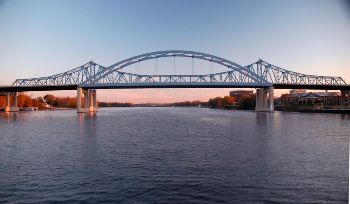Jun 11 2010
BNSF Railway Company (BNSF) announced today it will begin work this month on replacing seven approach spans on the Mississippi River bridge at Burlington, Iowa. Construction of the new approaches will complement a separate construction project that began last year to replace the bridge’s swing span with a new lift span over the navigation channel.
Construction of the replacement approach spans will use new reinforced concrete foundations with 250-foot steel bridge spans. When combined with the replacement of the movable span over the navigation channel, the entire bridge will have been rebuilt to 21st century engineering standards.
“The Burlington Bridge is a vital link in our nation’s transportation infrastructure. The new approaches will improve the Bridge’s overall rail capacity for freight and passenger movement,” said David Freeman, vice president, Engineering, BNSF. “Together with the new lift span, these approaches will mean an entirely new bridge that will benefit Iowa and Illinois, as well as customers and passengers all along the BNSF Chicago to Denver corridor.”
 Mississippi River Bridge at Burlington, Iowa
Mississippi River Bridge at Burlington, Iowa
BNSF decided to proceed with replacement of the approach spans to take advantage of an economically favorable construction environment. Walsh Construction of Chicago will be the prime contractor on the approach span project. The new approaches are scheduled to be complete by December 2011.
Lift Span Project Update
Work is also continuing on replacement of the Bridge’s old swing span with a modern lift span, which will increase the river navigation channel width from 150 feet to 307 feet 6 inches. By mid summer, Burlington residents will be able to see construction of the new truss for the lift span as it is assembled on barges downstream of the existing bridge. Ames Construction is the contractor on the lift span project, which is scheduled to be completed by March 2011. In addition to the lift span, one fixed span on the east side will be replaced with three smaller, temporary spans.
BNSF expects the fixed span will be floated out and replaced with the three temporary spans in early September. The temporary span replacement needs to be done to make way for the new lift span which will be floated into place in December of 2010. The lift span project is financed primarily through the American Recovery and Reinvestment Act of 2009 and previous appropriations under the Truman-Hobbs Act, which provides federal funding for altering bridges found to be unreasonably obstructive to navigation. The Burlington Bridge is one of the top three U.S. bridges most frequently struck by barges or towing vessels.
The Burlington Bridge is used by about 30 trains a day, including two Amtrak trains linking Chicago to Denver and points in between. The bridge opens about 300 times a month to let river traffic pass. About 24 million tons of waterborne commerce passed through the bridge in 2008.
Source: http://www.BNSF.com/